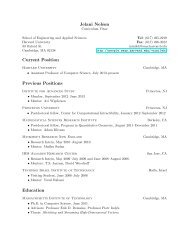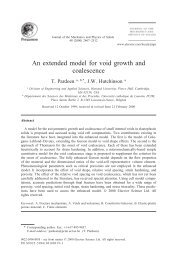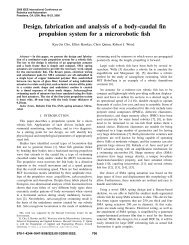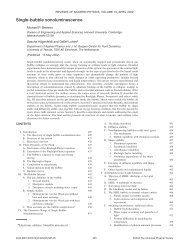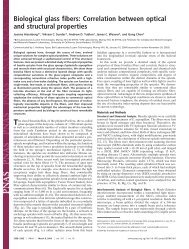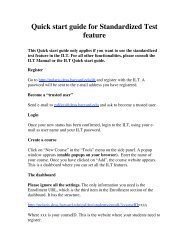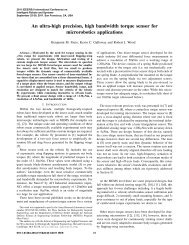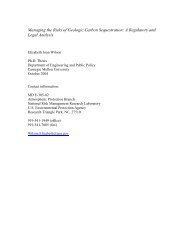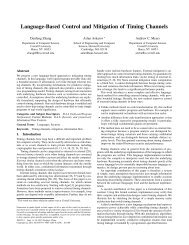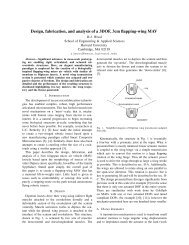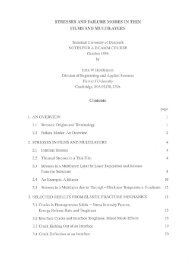CMOS RF Biosensor Utilizing Nuclear Magnetic Resonance
CMOS RF Biosensor Utilizing Nuclear Magnetic Resonance
CMOS RF Biosensor Utilizing Nuclear Magnetic Resonance
Create successful ePaper yourself
Turn your PDF publications into a flip-book with our unique Google optimized e-Paper software.
1636 IEEE JOURNAL OF SOLID-STATE CIRCUITS, VOL. 44, NO. 5, MAY 2009<br />
noise matching works well with a more general passive network<br />
containing a transmission line.<br />
To show this, let us work out the resonance noise matching in<br />
Fig. 8(d), based on our articulation of it from the previous subsection.<br />
The parameters of the transmission line are; characteristic<br />
impedance: , wave velocity: , length: , wave number:<br />
. We seek to find that maximizes for a fixed . Assume<br />
, although we can solve the problem generally.<br />
and in Fig. 8(d) are related through<br />
. The impedance is<br />
since<br />
. Therefore, the transmission line<br />
behaves like a capacitor<br />
at the coil end. Thus,<br />
to maximize , should resonate with at :<br />
The resulting maximum is again . This design is valid,<br />
as the line has a negligible measured loss (less than 0.05 dB for<br />
a 30 cm cable).<br />
(7)<br />
D. Design of the Low-Noise Amplifier<br />
As discussed in Section V-B, to minimize noise figure,<br />
should be maximized and the LNA’s input referred noise should<br />
be minimized. We have just discussed the former task. We now<br />
describe our LNA design to perform the latter. As<br />
is a prerequisite for maximum , a common source topology is<br />
chosen for the LNA. It has a capacitive input impedance, which<br />
may be regarded as infinite at low enough frequencies.<br />
Fig. 9 shows the schematic of our LNA. Since the design<br />
frequency, 21.3 MHz, is smaller than the noise corner<br />
( 50 MHz) of nMOS transistors in 0.18 m technology used,<br />
we use pMOS devices with the smaller noise corner ( 1<br />
MHz) [12] as input transistors and . pMOS transistors<br />
bring an additional benefit, the mitigation of the coupling of the<br />
substrate noise produced by the digital pulse generation circuits<br />
into the LNA input: the substrate noise would otherwise interfere<br />
with the weak signal at the LNA input, which is 4 even<br />
after the maximal passive amplification. On the same token,<br />
we must minimize the coupling of the strong local oscillator<br />
signal into the LNA input: it occurs first through the mixer,<br />
then, through the LNA’s input-output coupling capacitors. To<br />
minimize the latter coupling, cascode transistors and<br />
are used. Finally, to suppress the common mode noise, the<br />
amplifier is designed in a differential form and a common mode<br />
feedback circuit (CMFB) is employed. The capacitor and<br />
the resistor are for frequency compensation.<br />
With the arrangement above, the total noise of the LNA is<br />
dominated by the channel thermal noise of the transistors. The<br />
input referred noise of the LNA calculated through the standard<br />
small-signal analysis is given by<br />
where ( , 3 and 5) is the transistor ’s gate-source<br />
referred channel thermal noise. We have ignored the noise of<br />
the CMFB, and assumed perfectly matched differential pairs,<br />
to obtain the general guideline for how to size the transistors.<br />
(8)<br />
Fig. 9. LNA schematic.<br />
The third term is negligible as<br />
. To minimize the<br />
second term, active loads and are made much smaller<br />
than input transistors and : this leads to<br />
and the total input-referred noise is dominated by the first term,<br />
where is the transconductance of the<br />
input transistors. To reduce this first term, a large tail current (4<br />
mA) and wide input transistors (900 m) are used to maximize<br />
. From SPICE simulation, the input-referred noise of the<br />
LNA at 21.3 MHz is 1.3 and its voltage gain is 41 dB.<br />
Its input impedance, even with the wide input transistors, is still<br />
large enough at 21.3 MHz to guarantee .<br />
E. Comparison With the Inductively Source Degenerated LNA<br />
The passive amplification to minimize the noise figure is<br />
also employed in the inductively source degenerated LNA<br />
[Fig. 10(a)] widely used for wireless <strong>RF</strong> design [13], [14]<br />
although configured differently. As many designers are familiar<br />
with this LNA, here we compare it to our LNA.<br />
In the inductively source degenerated LNA of Fig. 10(a) designed<br />
for a wireless receiver, and are the input signal<br />
and noise from an antenna, while is the gate-source referred<br />
channel thermal noise of the transistor.<br />
is the antenna<br />
impedance. Inductors and and capacitor arranged<br />
around the transistor are chosen such that they resonate<br />
at the design frequency, and also present 50 to the antenna:<br />
in Fig. 10(a), . This 50 matching is<br />
required in wireless <strong>RF</strong> design, often reinforced by the band selection<br />
filter positioned between the antenna and the LNA. With<br />
such inductor and capacitor values, the network passively<br />
amplifies the input signal and noise, returning their amplified<br />
versions across the gate and source of the transistor [Fig. 10(b)]<br />
[13], [14]. The gain is , the effective



